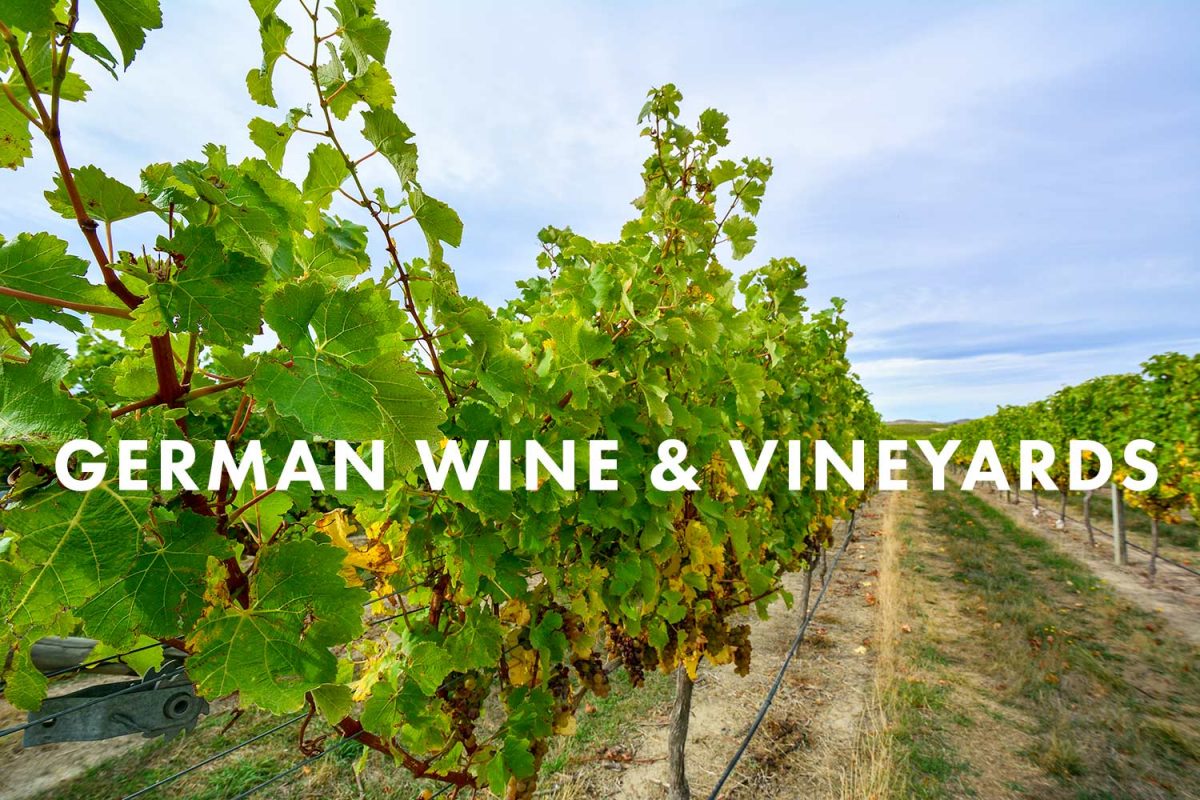
The sun-blessed vineyards of Baden
Baden Wine Route — Geographic Location: Southwest Germany.
The Baden Wine Route is incredibly diverse:
The Baden wine region stretches like a green ribbon for more than 400 kilometers from the River Tauber in the north to Lake Constance in the south.
With above-average temperatures for Germany, Baden has a similar climate to regions such as Alsace, Savoy and the Loire. On the southern slopes of the Kaiserstuhl, near Achkarren and Ihringen, you‘ll find Germany‘s warmest point.
Read more: Baden Wine Region, Germany
The Moselle: Germany’s oldest wine-growing region
Geographic Location: Western Germany.
The Moselle region is the oldest winegrowing area in Germany. As far back as Roman times, people were aware that the climate and fertile soil of the Rhenish Slate Mountains provided optimal conditions for making wine.
The region is one of the warmest in Germany with an average annual temperature of around ten degrees Celsius. It stays sunny well into the autumn and there is hardly any frost in winter.
Read more: Moselle Wine Region
Wines from Germany’s Nahe region
Sun-drenched hills, deep valleys and grapes on the vine…
Geographic Location: Western Germany.
The sunny south-western region of Germany where the Nahe river flows into the Rhine near Bingen (on the Rhine) is a paradise for gourmets and walkers alike, with its famously good food and top-class white wines. This region is sheltered by the Hunsrück hills and has the ideal climate for wine growing: mild temperatures and plenty of sunshine. The grapes ripen early and the wine develops pleasant acidity which makes it the ideal accompaniment to traditional local fare Spiessbraten (onion-marinated and flame-grilled steaks), which originated here, features in many guises on the menus of award-winning restaurants.
Read more: Nahe Wine Region
Silvaner wines from Franconia
Geographic Location: South-Western Germany.
Many of Franconia‘s famous wines are made from silvaner grapes. Silvaners are considered to be neutral wines, mildly acidic, with fine fruit flavours and a delicate bouquet. They are rich in minerals, spicy and ideal with both Franconia‘s hearty cuisine and more refined dishes. Silvaner is an old grape variety: it was first introduced in Germany back in 1665 by the Cistercian abbot Alberich Degen, who brought it from Franconia‘s Steigerwald region.
Read more: Franconia Wine Region
Rheingau Wine Region
Geographic Location: Western Germany.
The Statue of Germania towers high above the rolling hills of the Rheingau. She is 10.5 metres tall, weighs an impressive 32 tonnes and commemorates the re-establishment of the German empire following victory against the French in 1870/71. Construction of the Niederwald monument on which she stands began in 1877. The statue and monument are now a popular destination for visitors to the Rheingau, a narrow region extending from Wicker and Flörsheim on the Main river to Lorchhausen on the Rhine .
Read more: Rheingau Wine Region
Rheinhessen Wine
Geographic Location: Western Germany.
Rheinhessen is the largest wine-growing area in Germany with approx. 26,500 hectares of vineyards. It lies to the left of the Rhine loop between Bingen am Rhein and Worms, and extends west as far as the Nahe and Alsenz rivers. Despite its name, which has historical origins, today Rheinhessen is part of the federal state of Rhineland- Palatinate.
Read more: Rheinhessen Wine Region
Dornfelder wines from the Palatinate
Geographic Location: South-Western Germany.
The Palatinate, a region of varied scenery, lies to the west of the Rhine and of towns such as Ludwigshafen, Germersheim and Speyer.
It is home to the second largest wine-growing area in Germany, with approx. 23,000 hectares under cultivation. The fertile soil and mild climate allow not only around two dozen grape varieties to thrive in the hills of the German Wine Route, but also figs, kiwis and lemons.
Read more: Palatinate Wine Region
Saale-Unstrut wine-growing region, northeast Germany
Geographic location: Northeast Germany, west of Leipzig
The Saale-Unstrut region in the north-east of Germany is a true insiders’ tip, not only for visitors with an interest in history and lovers of medieval architecture, but especially for wine buffs.
Over an area of 664 hectares in Europe‘s most northerly wine-growing area, more than 40 wine-growing estates cultivate 30 different grape varieties.
Read more: Saale-Unstrut Wine Region
Middle Rhine wine region:
Wine and culture along the Middle Rhine.
Geographic location: Western Germany
The Middle Rhine wine region extends from Bingen to the outskirts of Bonn. Punctuated by sheer ridges overlooking the river, the narrow Rhine valley is renowned for its picturesque scenery, not least because of the beautiful but labour-intensive vineyards, most of which are on steep hillsides.
In 2002, UNESCO saw fit to bestow World Heritage status upon the Upper Middle Rhine Valley between Bingen and Koblenz.
Read more: Middle Rhine Wine Region
Ahr Valley Wine Region
Geographic location: Western Germany
Few wine-growing regions are found further north in Germany in the Ahr valley.
Read more: Ahr Valley Wine Region
Saxony Wine Region
Geographic location: Eastern Germany
Vineyards have been a feature of the Elbe Valley landscape in Saxony for more than 800 years. Although the region is better known for the world-renowned Semper Opera House and magnificent waterfront palaces in Dresden, telltale signs of its wine-growing tradition are evident in decorations on the famous Meissen porcelain.
Related topic: German Porcelain
Read more: Saxony Wine Region

